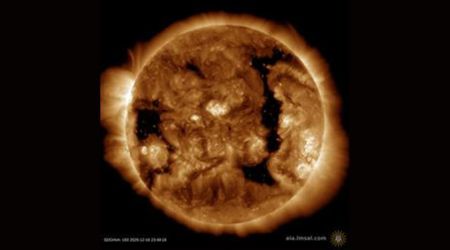How far away is Neptune

How far away is The Neptune now?
Last Updated: Today
Where does this live distance data come from?
I source Neptune's distance from Earth via the Horizon JPL API. It is a free service provided by NASA's Jet Propulsion Laboratory (JPL) that offers access to ephemeris (positional) data and related information for celestial bodies, such as planets, asteroids, and comets. The system can be accessed through various interfaces, including a web interface, a telnet interface, and an email interface.
This API contains the precise distance between Neptune and Earth from each day of the next few hundred years.
So I simply created a system to check for today's date, then go retrieve the accurate distance value directly from NASA's database. The up-to-date value is then displayed on this page.
How do scientists calculate the real-time distance between Neptune and earth?
Scientists calculate the live distance between Neptune and Earth using a combination of mathematics, astronomical data, and the principles of celestial mechanics.
The positions of Earth and Neptune in their respective orbits are constantly changing due to their elliptical orbits and different orbital periods around the Sun.
Neptune's orbital parameters
Orbital parameters describe the way objects move around in space, such as planets, moons, and satellites. These parameters include the size, shape, and tilt of the orbit, as well as the object's position and speed within the orbit.
They help scientists understand and predict the paths of celestial bodies, which is crucial for planning space missions, observing astronomical phenomena, and monitoring satellites.
| Measure | Neptune | Earth | Ratio (Neptune/Earth) | Definition |
|---|---|---|---|---|
| Semimajor axis (106 km) | 4,514.953 | 149.598 | 30.178 | Half of the major axis of the elliptical orbit |
| Sidereal orbit period (days) | 60,189 | 365.256 | 164.79 | Time it takes to complete one orbit around the sun |
| Tropical orbit period (days) | 59,799.9 | 365.242 | 163.73 | Time between two consecutive vernal equinoxes |
| Perihelion (106 km) | 4,471.050 | 147.095 | 30.396 | Closest distance to the sun in the orbit |
| Aphelion (106 km) | 4,558.857 | 152.100 | 29.973 | Farthest distance from the sun in the orbit |
| Synodic period (days) | 367.49 | - | - | Time it takes for the object to reappear at the same point in the sky |
| Mean orbital velocity (km/s) | 5.45 | 29.78 | 0.183 | Average speed at which the object orbits around the sun |
| Max. orbital velocity (km/s) | 5.47 | 30.29 | 0.181 | Maximum speed at which the object orbits around the sun |
| Min. orbital velocity (km/s) | 5.37 | 29.29 | 0.183 | Minimum speed at which the object orbits around the sun |
| Orbit inclination (deg) | 1.770 | 0.000 | - | Angle between the object's orbit plane and the ecliptic plane |
| Orbit eccentricity | 0.0097 | 0.0167 | 0.581 | Measure of how much the orbit deviates from a perfect circle |
| Sidereal rotation period (hrs) | 16.11* | 23.9345 | 0.673 | Time it takes for the object to complete one rotation on its axis |
| Length of day (hrs) | 16.11 | 24.0000 | 0.671 | Time for the planet to rotate once relative to the Sun (solar day) |
| Obliquity to orbit (deg) | 28.32 | 23.44 | 1.208 | Angle between the object's rotational axis and its orbital axis |
| Inclination of equator (deg) | 28.32 | 23.44 | 1.208 | Tilt of the object's equator relative to its orbit |
Neptune at opposition (for the next 3 years)
When astronomer talks about Neptune being at opposition, it means that the ice giant, the Earth, and the Sun are aligned in a straight line, with Earth in the middle. During this time, which lasts for a few weeks, Neptune appears brighter and larger in the sky because it's at its closest point to Earth in its orbit.
Neptune reaches opposition approximately once a year, providing astronomers and stargazers with an amazing opportunity to observe and admire the ice giant planet.
Below you can find a list of opposition dates for the next 3 years:
| Date & Time (PDT) | Date & Time (UTC) | Object | Right Ascension | Declination | Constellation | Magnitude | Angular Size |
|---|---|---|---|---|---|---|---|
| TUE, 19 SEP 2023 AT 04:09 | 11:09 | Neptune | 23h47m00s | 2°47'S | Pisces | 7.8 | 2.4 |
| FRI, 20 SEP 2024 AT 17:08 | 00:08 | Neptune | 23h55m20s | 1°56'S | Pisces | 7.8 | 2.4 |
| TUE, 23 SEP 2025 AT 05:45 | 12:45 | Neptune | 00h03m30s | 1°06'S | Pisces | 7.8 | 2.4 |
Just for fun, how long would it take to reach Neptune via different transportation means
Neptune is the farthest planet in the solar system: the average distance between Earth and Neptune is mind blowing 2.8 billion miles (4.5 billion kilometers), so based on that distance, I have calculated the time it would take to reach the ice giant at the speed of different means of transportation.
- On foot (3 mph): approximately 106,575.34 years
- Bicycle (15 mph): approximately 21,315.07 years
- Horse (galloping at 25 mph): approximately 12,789.04 years
- Motorbike (average speed of 70 mph): approximately 4,539.68 years
- Boat (cruising speed of 23 mph): approximately 13,904.37 years
- Car (60 mph): approximately 5,322.52 years
- High-speed train (200 mph): approximately 1,596.76 years
- Commercial Airplane (575 mph): approximately 556.41 years
- Concorde supersonic jet (1,350 mph): approximately 236.99 years
- SpaceX Starship (projected average speed of 16,777 mph): approximately 19.03 years
Please note this is only for fun and it does not reflect the reality of space travel. This is a simplification and does not account for acceleration, deceleration, or the gravitational influences of celestial bodies which would play significant roles in actual space travel.
Also, these calculations assume constant speed, which is not how actual space travel works. A real trip to Neptune would be faster due to the spacecraft picking up speed from gravitational assists.
Bonus Fact: On average it takes about 4-4.5 hours for light from Neptune to reach Earth.
How far away are the other planets of the solar system?
I have developed a webpage that monitors the real-time distances between Earth and each planet of the solar system:
- Real-time distance between the Moon and Earth
- Real-time distance between Mercury and Earth
- Real-time distance between Venus and Earth
- Real-time distance between Mars and Earth
- Real-time distance between Jupiter and Earth
- Real-time distance between Saturn and Earth
- Real-time distance between Uranus and Earth
- How far away is Earth from the Sun?









